| 1 | A Californian pond dweller |
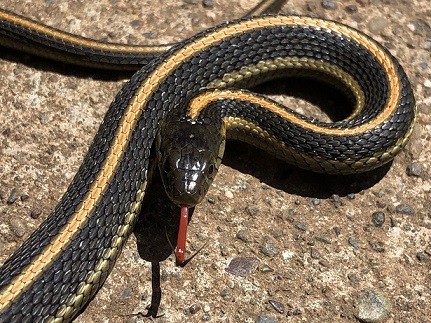
The aquatic garter snake is a species of just two American states: California and Oregon. As its name suggests, it’s a water-lover, which isn’t fully aquatic like a seasnake, but can hold its breath underwater for long periods and is an excellent swimmer.
You won’t find this snake floating in stormy seas after your boat capsizes. Instead, aquatic garter snakes (Thamnophis atratus) can be found in water bodies within woodlands, rocky hillsides and grassy plains, with their favourites being shallow streams with a rocky base. Ponds are another hotspot, and they’re more common in smaller streams than wide rivers.
Thamnophis atratus is one of the easiest garter snakes to recognise. They have virtually black scales, contrasting sharply against a vivid yellow (or orange) stripe running down their spine. This line ends just before the skull, transitioning to a mostly black face. They have a bright red tongue with a black tip, while their eyes are a dull grey colour.
Aquatic garter snakes are a moderate length. The record length is 101.6cm, but most males are 80cm with females slightly longer at 85cm. This is a harmless snake which possesses a mildly venomous saliva, and has a docile personality even within the docile garter snake family.
| 2 | Immune to fast, raging currents |
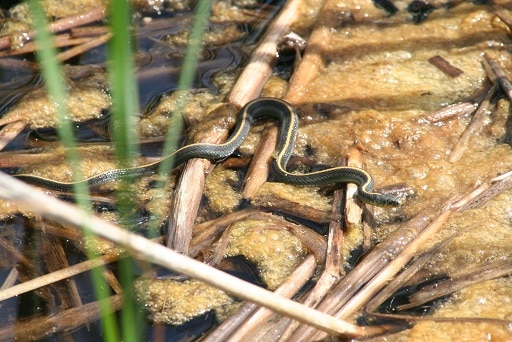
Aquatic garter snakes can be seen: resting on lily pads, following patiently behind an oblivious frog, and weaving their way through an obstacle course of floating twigs and vegetation. They occasionally climb low tree branches, and will sometimes rest on rocks by their stream hangouts.
Nevertheless, it’s rare for this snake to stray too far from water. A study from St Lucia Preserve in California found that while the local common garter snakes averaged at 20 metres from the water’s edge, and the terrestrial garter snakes (Thamnophis elegans) up to 50 metres, the aquatic garter snakes stayed within an invisible line just 1 metre from the shore.
Aquatic garter snakes are strong swimmers, and they gain power with age. As newborns, they stick to the shallow edges, before venturing into riffles as juveniles, shallow water flowing over rocky streambeds. As adults, they graduate to the fastest-flowing sections, with total immunity to the raging currents. Thamnophis atratus is a day-faring snake, which only becomes nocturnal on particularly hot days.
| 3 | Water-adapted eyes |
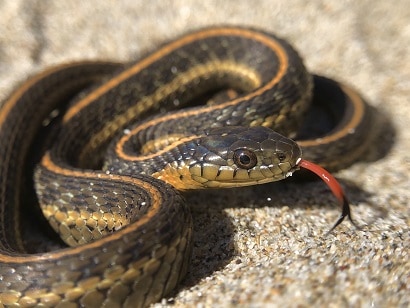
Aquatic garter snakes have round pupils, which enlarge or shrink like a human being’s. However, this isn’t in response to light. Instead, the aquatic garter snake’s pupil size is tied to water. They dilate while submerging to the depths, most likely to compensate for the haziness and defocus being underwater brings. As they hunt by prowling along streambeds, even a tiny edge in vision could give them a survival advantage.
Among all snakes on Earth, the aquatic garter snake’s closest relative is the giant garter snake. They both prefer watery marshes and streams, but have no overlap in territory whatsoever. The aquatic garter snake chose the west coast of Oregon and California, while Thamnophis gigas is only found in California’s central Sacramento and San Joaquin valleys. Giant garter snakes are larger, but a feature they share is a relatively long snout compared to other garter snakes.
| 4 | No mammals, plenty of frogs |
Living in rivers and ponds, Thamnophis atratus has the diet you’d expect: 80-90% frogs and toads, with salamanders taking over in certain spots. In Saint Lucia Preserve, 83% of their prey were frogs. The aquatic garter snake ate no mammals at all, unlike the terrestrial garter snake they overlapped with. Juveniles stick to smaller prey such as tiny black tadpoles darting about, and the smallest fish species which reside on stream edges.
A study from Hurdygurdy creek in northern California found that as adults, their top prey species was the coastal giant salamander. However, a wider study from 85 different ponds across the San Francisco Bay area found that the Pacific chorus frog ranked first. The next ranked were Western toads (Anaxyrus boreas), California newts and California red-legged frogs.
Out of aquatic garter snakes with prey in their bellies, 93% contained frogs. The study also found that frogs and Thamnophis atratus had a strong correlation – the more frogs hopping around a pond, the more likely that aquatic garter snakes would be lurking.
| 5 | Lures prey with its tongue |
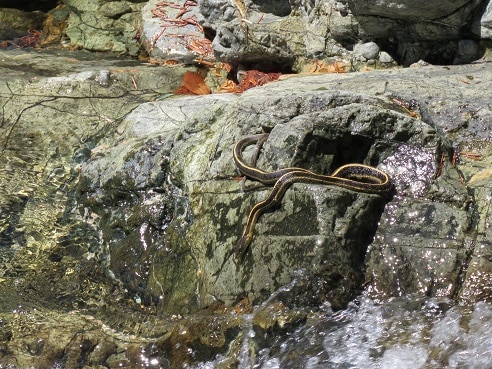
The aquatic garter snake changes its hunting style with age. Younglings prefer to swallow up many small prey, while adults slurp down one large meal every couple of weeks. Hatchlings and juveniles are also much more reliant on ambush. Adults submerge themselves and prowl along the rocky streambed, which is overwhelmingly their favourite strategy. But young aquatic garter snakes prefer to rest motionless, disguised by vegetation on the river edges, craning their head forward slightly to gain a better view.
These younglings also have a special tactic: tongue luring. Poking their head towards the water, they extend their red tongues and poke just the black tip below the surface. Most of the tongue is kept completely rigid, but the deceptive snakes wiggle the darker end, in order to attract fish which confuse them for insects.
A 2000 study found that this was clearly separate from the usual tongue flecking that all snakes do, as they stuck their tongue out for 4.7 seconds at a time while luring, compared to 0.43s while seeking scents. Aquatic garter snakes have been observed performing this trick to capture rainbow trout and chinook salmon.
| 6 | Vulnerable to invasive bullfrogs |
As they grow into adults, aquatic garter snakes mostly abandon their tongue waggling ways. Instead, nature gives them a large injection of fitness and endurance. Adult aquatic garter snakes move over 5 times faster than younglings. They can also move at their respective maximum speed for 5 to 8 times longer. Hence, they can cope with fast-flowing streams whereas younglings would be washed down the valley.
In the study earlier, there was only one amphibian Thamnophis atratus had a negative correlation with: the American bullfrog. This is an invasive species, and a cocky, greedy one at that. They’re responsible for declines in native amphibians such as red-legged frogs, thus reducing the food supply for aquatic garter snakes. The worst thing is that their tadpoles are unpalatable to predators, reducing any checks on their population explosion. American bullfrogs have also been spotted eating Thamnophis atratus on occasion.
Another prey of aquatic garter snakes is Salvelinus fontinalis, AKA brook trout. This snake lays live young rather than eggs, in batches of 3-12.
| 7 | Swallows poisonous newts with ease |
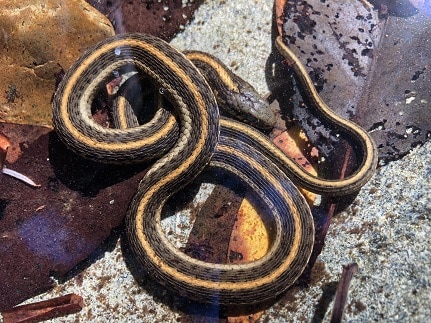
The common garter snake is famous for being resistant to tetrodotoxin, the poisonous defensive weapon of many American newt species. They can eat these newts without trouble, whereas other snakes grind to a total paralysed halt, dying quickly after.
The aquatic garter snake shares this resistance to tetrodotoxin, and may take it further. There’s large variation, with some swathes having strong resistance and others a minimal level. The most resistant Thamnophis atratus are found in California’s central coast, and are in fact the most TTX-resistant snakes yet discovered by science. It’s estimated that to reduce these aquatic garter snakes’ slither speed by 85%, you would have to give them 900 times the lethal dosage in humans. These supersnakes reside in places like Molino Creek in Santa Cruz County, and Pilar Point Harbor, San Mateo County.
The exact genetic mutations are mysterious. TTX works by blocking sodium channels, thus preventing neurotoxins from firing, causing paralysis. Common garter snakes are resistant primarily due to the gene Nav1.4, which alters the sodium channel shape, but this only accounted for 23% of resistance in the aquatic garter snake.
| 8 | Don’t eat them! |
The aquatic and common garter snakes diverged millions of years ago. It’s believed that they share the genetic base for tetrodotoxin resistance, but that the final gene alterations and expressions that it allowed for resistance to take effect happened independently. They also evolved resistance in response to separate species: the rough-skinned newt for Thamnophis sirtalis, and California newt for aquatic garter snakes.
Aquatic garter snakes likely have another deadly power. Common garter snakes actually store tetrodotoxins from newts they consume in their bodies, making them fatal for bird predators, with neurotoxins frazzling their brains. While unconfirmed, there’s a strong chance that aquatic garter snakes also accumulate a nice toxin stash.
Aquatic garter snakes have formed vast gatherings in the past, with stunned hikers watching on with awe. However, this isn’t out of any desire to greet each other, but because they’re all arriving at the same food source. Foothill yellow-legged frogs are one species which tend to form vast breeding colonies in shallow streams with rocky beds. Sniffing these out, the local aquatic garter snakes will arrive in their wake, concentrating in one small water body.
| 9 | Their garter snake rival |
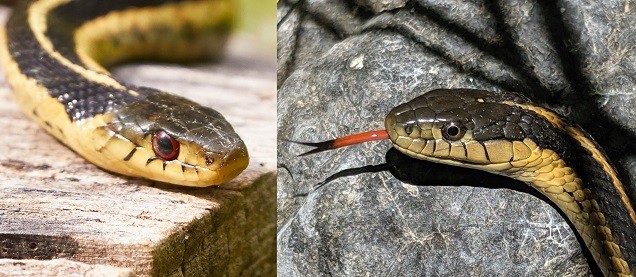
There’s one animal that the aquatic garter snake loathes, and will flee to avoid, even if it means leaving their comfortable rocky streams. That animal isn’t a menacing hawk, but its relative the common garter snake (Thamnhophis sirtalis). The two species often overlap in California and Oregon, and a 2014 study decided to analyse the conflicts that erupted when they came face to face.
It turned out that when the two species were isolated from each other, in the protected St Lucia Preserve, they chose streams rich with amphibians 100% of the time. But when they mixed, the common garter snakes always seized control of the streams, with the aquatic garter snakes fleeing to grassy areas far away. In a lab experiment, Thamnophis sirtalis repeatedly bit its aquatic cousin, in savage displays of bullying. Meanwhile, Thamnophis atratus almost never acted aggressively, proving that it’s one of the calmer garter snake species. It was probably just confused as to why its common garter cousin was acting so unreasonably.
This dominant personality explains why common garter snakes inhabit every US state except Arizona, while aquatic garter snakes are restricted to Oregon and California.
| 10 | Three subspecies |
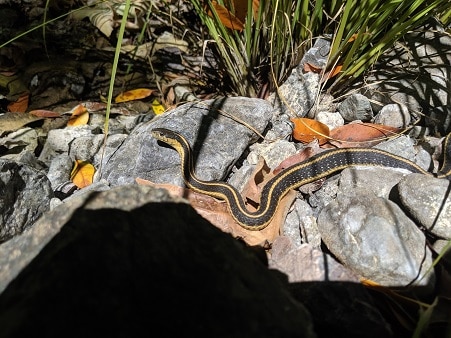
Aquatic garter snakes have three subspecies. The Oregon garter snake (Thamnophis atratus hydrophilus) lives the furthest north, while the Diablo garter snake (T. a. zaxanthus) lives the furthest south, occupying a large part of California’s coast. Sandwiched inbetween is a small parcel of land, ruled by the Santa Cruz garter snake (T. a. atratus). There’s also a grey zone where the three subspecies intermingle and interbreed.
The Diablo version is clearly separate, as the pale stripe down its spine is a vivid orange, and the black scales between are usually clean, adorned with few markings. This has the most sharply contrasting colours of the three. The Oregon version has paler yellow stripes, and light speckles on random areas between the stripes. The Santa Cruz version is the simplest: they only have one stripe, missing the line on each flank, while keeping the strong yellow stripe down the spine.
The Oregon aquatic garter snake has the dullest colours overall. A small portion are missing the signature garter snake stripes altogether, being a consistent car tyre grey instead.
